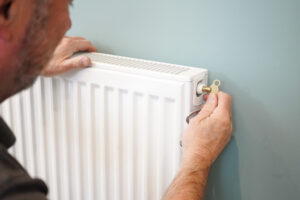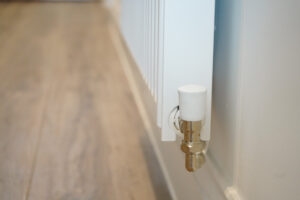Step-by-Step Guide: How to Bleed Your Radiators
If your home feels colder than it should or you notice uneven heating in your radiators, trapped air might be the issue. Learn how to bleed your radiators to resolve this. It is a cost-effective fix that you can do yourself in just a few minutes.
What You’ll Need:
- Radiator key (available at DIY stores)
- A cloth or small towel
- A bowl or container
- Optional: gloves for added protection
Step 1: Check If your radiators need bleeding
Before you start, ensure your radiators actually need bleeding. Turn your heating system on and let it run for 10-15 minutes. Then, check each radiator:
- Are there cold spots, especially at the top?
- Do you hear gurgling or hissing noises?
If so, it’s likely time to bleed your radiators.
Step 2: Turn Off the Heating
Turn off your heating system and let it cool down. This prevents hot water from spurting out and reduces the risk of burns.
Step 3: Locate the Bleed Valve
Find the bleed valve on your radiator. This is typically a small, square-shaped valve located at the top corner of the radiator. You’ll use the radiator key to turn it.
Step 4: Position Your Tools
Place a towel or cloth around the bleed valve to catch any drips. Hold a bowl or container underneath the valve to catch any water that escapes.
Step 5: Open the Bleed Valve
Insert the radiator key into the bleed valve and turn it slowly anti-clockwise. You’ll hear a hissing sound as the trapped air escapes. Be careful not to open the valve too far—a quarter turn is usually enough.
Step 6: Close the Valve
Once the hissing stops and water begins to flow steadily, quickly turn the key clockwise to close the valve. Ensure it’s snug but not overly tight.
Step 7: Check the Boiler Pressure
Bleeding radiators can lower the pressure in your boiler system. Check the pressure gauge on your boiler:
- If it’s below the recommended level (usually 1-2 bars), you’ll need to top it up using the filling loop.
Consult your boiler’s manual for instructions on how to do this.
Step 8: Test Your Heating
Turn your heating system back on and let it run for a while. Check each radiator to ensure they’re heating evenly. If not, repeat the bleeding process as needed.
Tips:
- Start with the closest radiator: Begin with the radiator nearest to your boiler and work your way to the farthest one.
- Bleed regularly: Aim to bleed your radiators at least once a year, especially before winter.
- Watch for recurring issues: If you’re bleeding your radiators frequently, it might indicate a bigger issue with your heating system. Consider calling out an engineer to have a look at the boiler.










